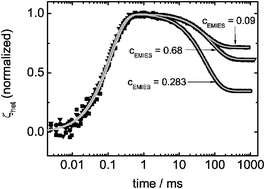In the present work we investigate the thermal diffusion behavior of three different binary mixtures with a thermal lens (TL) setup. In the setup used in this study we avoid the addition of a dye for systems, such as aqueous mixtures, with a weak absorption band at a wavelength of 980 nm. In some aqueous systems with a complex phase behavior the addition of dye significantly affects the apparent measured thermal diffusion properties. The studied systems are dimethylsulfoxide (DMSO) in water, the ionic liquid 1-ethyl-3-methylimidazolium ethylsulfate (EMIES) in butanol and a non-ionic surfactant hexaethylene glycol monododecyl ether (C12E6) in water. The Soret coefficients of the selected systems cover a range of two orders of magnitude. For DMSO in water with a very low Soret coefficient of the order of ST∼ 10−3K−1 we find for a low DMSO content (c = 0.33) a reasonable agreement with previous measurements, while the weak thermal lens signal for the DMSO-rich mixture (c = 0.87) leads to 20% too large Soret coefficients with an uncertainty of more than 30%. Secondly we studied a liquid salt 1-ethyl-3-methylimidazolium ethylsulfate (EMIES) in butanol with a roughly ten times higher Soret coefficient of ST∼ 10−2K−1. For this system we performed additional measurements with another experimental technique, the classical thermal diffusion forced Rayleigh scattering (TDFRS), which requires the addition of a small amount of dye to increase the absorption. In the entire investigated concentration range the results obtained with the TL and classical TDFRS technique agree within the error bars. As a third system we studied a non-ionic surfactant hexaethylene glycol monododecyl ether (C12E6) in water with a Soret coefficient of the order of ST∼ 10−1K−1. For this system we find good agreement with previous measurements. We conclude that the TL technique is a reliable method for systems with a strong optical contrast and fairly large Soret coefficient of the order of ST∼ 10−2K−1.

You have access to this article
 Please wait while we load your content...
Something went wrong. Try again?
Please wait while we load your content...
Something went wrong. Try again?


 Please wait while we load your content...
Please wait while we load your content...